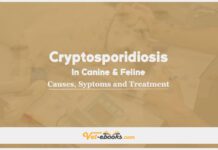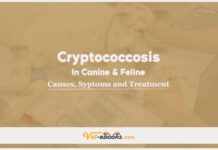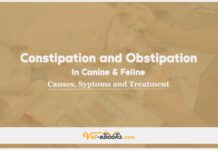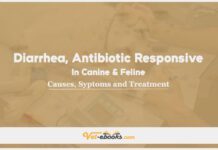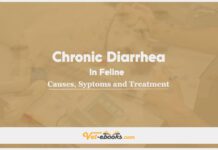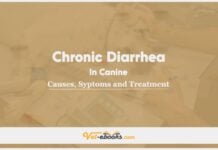Actinomycosis, Nocardia In Canine and Feline: Causes, Symptoms and Treatment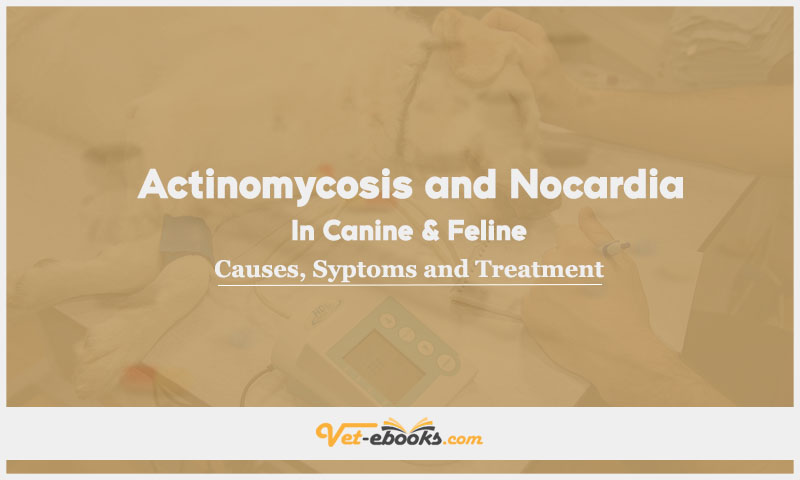
Overview
Opportunistic bacterial infections caused by Gram-positive bacteria with branching characteristics, resulting in similar suppurative to granulomatous inflammation.
-Actinomyces spp. (anaerobic to microaerophilic bacteria found in the normal flora of mucous membranes, gastrointestinal, and urogenital tracts).
– Nocardia spp. (aerobic bacteria typically found in soil).
Causes of Actinomycosis and Nocardia In Canine and Feline
- Scratches and bites leading to wounds.
- Traumatic introduction of the bacteria.
- Migration of foreign objects into the body (such as grass awns).
- Weakening of the immune system, particularly in cases involving Nocardia infection.
Pathogenesis of Actinomycosis and Nocardia In Canine and Feline
- It varies depending on whether the infection remains confined to a specific area or spreads throughout the body (in the case of Nocardia) and which organ systems are affected.
- In cats, it is frequently observed as localized swelling in the skin and underlying tissues (cervicofacial swelling in the case of Actinomyces), abscesses, or persistent wounds with draining passages; localized skin lesions with drainage are a common presentation.
Symptoms (History & Physical Examination) of Actinomycosis and Nocardia In Canine and Feline
- Pain, discomfort, elevated body temperature, and loss of weight.
- Accumulation of fluid with inflammation in the chest or abdominal cavities.
- Coughing, dyspnea, and reduced sounds from the front part of the lungs (known as empyema).
- Limping due to bone infections (osteomyelitis).
- Impairments in both motor and sensory functions.
- Retroperitonitis (associated with Actinomyces) characterized by pain in the lower back and partial or complete loss of function in the rear limbs.
Diagnosis of Actinomycosis and Nocardia In Canine and Feline
1- From History and Physical Examination
2- Diagnostic Procedures
- Gram staining, cytology, and acid-fast staining are informative diagnostic methods, although they do not eliminate the necessity for culturing the bacteria. In the case of Actinomyces, acid-fast staining usually yields negative results, while with Nocardia, the staining results can vary. The presence of sulfur granules typically indicates Actinomyces infection.
- For a conclusive diagnosis, submitting exudates or fragments of bone tissue with osteolytic changes in both aerobic and anaerobic specimen containers for culture is essential (refer to Anaerobic Infections).
- In instances where Nocardia infection does not respond to empiric therapy, it may be necessary to identify the specific Nocardia species causing the infection.
Pathological Observations
When examined under a microscope, the tissue samples typically show pyogranulomatous or granulomatous inflammation with clusters of filamentous bacteria. The use of special stains can improve the visibility of these bacteria. While sulfur granules can be a valuable diagnostic indicator, they may sometimes prove challenging to locate.
CBC/Biochemistry/Urinalysis Results:
- Anemia without the body’s ability to regenerate red blood cells.
- Elevated white blood cell count with a shift towards immature forms (left shift) and an increase in monocytes.
- Higher-than-normal levels of globulin in the blood.
- Elevated levels of ionized calcium in the blood (notably in cases of nocardiosis).
Imaging Findings:
- The choice of imaging depends on the affected organ systems.
- Thoracic X-rays may reveal an alveolar and interstitial lung pattern with the possibility of alveolar disease, pleural effusion (in the case of pyothorax), and subcutaneous masses.
- Abdominal X-rays can indicate peritoneal effusion and the presence of masses in the abdomen.
- X-rays of infected bones may show new bone formation on the outer surface (periosteal new bone), reactive hardening of bone tissue (osteosclerosis), and bone loss (osteolysis).
3- Differential Diagnosis
- Distinguishing between Actinomyces and Nocardia infections is challenging, as they exhibit similar characteristics and cannot be consistently differentiated using Gram staining, cytology, or clinical symptoms. Actinomyces infections often occur alongside several other concurrent bacterial infections.
- It’s crucial to consider alternative explanations for similar clinical presentations, such as other bacterial or fungal infections, the presence of tumors (neoplasia), and various diseases that can lead to the development of effusions.
- Cutaneous: Conditions to consider for skin-related issues include Actinomycosis, unusual mycobacterial infections, leprosy, fungal infections, abscesses from wounds, and drainage tracts caused by foreign bodies.
- Pleural: When dealing with pleural concerns, potential diagnoses include bacterial pyothorax, thoracic tumors (neoplasia), and chronic diaphragmatic hernia.
- Disseminated: In cases of systemic dissemination, possible causes may include systemic fungal infections and feline infectious peritonitis (FIP).
Treatment of Actinomycosis and Nocardia In Canine and Feline
General:
- Extended courses of antimicrobial treatment are necessary.
- Surgical removal or excision of infected tissue, such as a lung lobe or a mass in the body wall, could potentially enhance the prognosis.
- Drainage of exudative fluid (found in the chest, abdomen, or beneath the skin) should be performed, and the infected cavity must be cleaned.
- In cases of pyothorax in cats, the placement of a thoracostomy tube with intermittent or continuous drainage is typically required.
- Dogs may benefit from thoracic exploration before thoracostomy tube placement to attempt the removal of foreign bodies, if present.
- Supportive care may include intravenous fluid therapy, with or without nutritional support.
- For fistulous tracts and abscesses, surgical drainage and debridement are necessary, followed by long-term antibiotic therapy.
Medications:
It is crucial to differentiate between Actinomyces and Nocardia infections in order to choose the most suitable antimicrobial therapy.
Antibiotics typically necessitate a prolonged treatment regimen, often spanning weeks to months, and should be continued for several weeks even after all symptoms have resolved.
- For Actinomycosis, penicillins are regarded as the preferred choice of antibiotics. Amoxicillin is commonly prescribed at a dosage of 20–40 mg/kg orally every 8 hours.
- For Nocardiosis initial antibiotic options include sulfonamides like sulfadiazine or a combination of trimethoprim and sulfadiazine.
- Additional effective antibiotics include gentamicin, amikacin, doxycycline, tetracycline hydrochloride, minocycline, and erythromycin either alone or in combination with ampicillin or amoxicillin.
- Amoxicillin can also be employed in conjunction with an aminoglycoside in treatment of Nocardiosis.
Some Notes:
- Avoid administering aminoglycosides to animals that are poorly hydrated. Monitor for potential renal tubular damage by observing the urine sediment for the presence of hyaline casts.
- Dogs may experience toxic or hypersensitivity reactions to sulfonamide antibiotics.
- Prolonged use of sulfonamide drugs can lead to conditions like polyarthritis, keratoconjunctivitis sicca (KCS), and blood disorders. This can be prevented by supplementing with folate administration (1 mg orally every 24 hours).
- Even after apparent clinical improvement, it’s essential to closely monitor the patient for the first year post-infection. Watch for the development of symptoms such as fever, weight loss, neurological signs, breathing difficulties, and lameness, as bone and central nervous system (CNS) involvement could still occur.
- Achieving complete clearance of the infection can be challenging.
- There is a possibility of infection reemergence after antibiotics are discontinued.
- Actinomyces infections in dogs can achieve a reported cure rate of up to 90% with appropriate therapy.
- In the case of Nocardia, there is a reported mortality rate of up to 50%.
- For prevention: Avoiding areas where grass awns are present, Taking steps to prevent bites and scratches.
Do You Want To Increase Your Veterinary Knowledge and Practical Skills?
You Can Now Browse and Download +3000 Books For Veterinary Professionals & Students Online.
Download Veterinary Books

